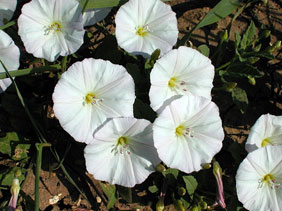FIELD BINDWEED
|
 |
| File Size: 86 KB |
|
|
|
Convolvulus arvensis L.
|
| Mitchell County, Kansas |
| Perennial |
| Height: Trailing on the surface or climbing |
| Family: Convolvulaceae - Morning Glory Family |
| Flowering Period: June, July, August |
|
| Also Called: | | Creeping jenny, small-flower bindweed, possession vine. | | Stems: | | Vine, 4 to 80 inches long, slender, decumbent or climbing, twining, glabrous to sparsely and minutely hairy. | | Leaves: | | Alternate, simple, variable, ovate or ovate-oblong to triangular, .4 to 4 inches long, .2 to 2.4 inches wide, glabrous or minutely hairy; margins entire or somewhat wavy; tip rounded to sharply pointed; base heart-shaped to nearly truncate, sometimes arrowhead-like; basal lobes blunt or pointed, spreading or pointing downward, sometimes with 2-3 shallow teeth; stalk 1/8 to 1.6 inch long; blade is usually level with the stalk. | | Inflorescences: | | Solitary flowers or loose clusters of 2-3, in leaf axils; stalks .4 to 3.6 inches long; bracts 2, scale-like, elliptic, linear or obovate, 1/12 to 1/8 inch long, located .8 to 1.2 inches below flower. | | Flowers: | | Calyx bell-shaped; sepals 5, obovate to oblong, 1/8 to 1/5 inch long, margins usually hairy; corollas bell-shaped to funnel-shaped, 1/2 to 1 inch long, shallowly 5-lobed, white to pinkish; stamens 5, unequal, 1/3 to 1/2 inch long, not extending beyond corolla. | | Fruits: | | Capsule, nearly spherical to egg-shaped, 1/5 to 1/4 inch in diameter, glabrous; seeds 1-4, egg-shaped, 1/8 to 1/6 inch long, glabrous, dull, rough, brownish-gray to black. | | Habitat: | | Open disturbed sites, cultivated and fallow fields, waste areas, stream banks, pastures. | | Distribution: | | Throughout Kansas. | | Origin: | | Eurasia. Thought to have arrived in the U.S. in the mid-eighteenth century when it was cultivated as an ornamental and medicinal herb. Escaped and naturalized by the mid-ninetheeth century. | | Toxicity: | | The seeds and foliage can cause mild digestive disturbance in livestock, but treatment is generally not needed. | | Uses: | | Native Americans used a cold infusion as a wash for spider bites and used the stems as cords to carry birds and small mammals after hunting. | | Comments: | | Forms large, dense mats. The flowers open in the late morning and close again by late afternoon. From Latin convolvere "to twine". Field bindweed is a serious weed that has been declared noxious in many states. It is very difficult to eradicate. The root system is extensive with roots that can go down to 13+ feet. If cut or dug, the rhizomes that remain in the ground will send up new shoots. The seeds can remain viable as long as 50 years! |
|
| Field bindweed |  | | 88 KB | | Mitchell County, Kansas |
| | Field bindweed |  | | 129 KB | | Mitchell County, Kansas |
| | Field bindweed leaf |  | | 74 KB | | Konza Prairie, Riley County, Kansas |
| | Field bindweed flower |  | | 45 KB | | Konza Prairie, Riley County, Kansas |
| | Field bindweed climbing |  | | 61 KB | | Konza Prairie, Riley County, Kansas |
| | Field bindweed |  | | 127 KB | | Konza Prairie, Riley County, Kansas |
| | Field bindweed twining |  | | 101 KB | | Ottawa County, Kansas |
| | Field bindweed |  | | 202 KB | | Ottawa County, Kansas |
| | |
|
|
|
|
|
|










